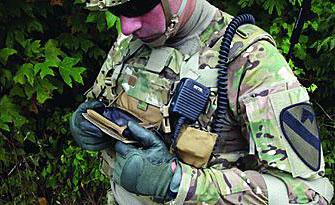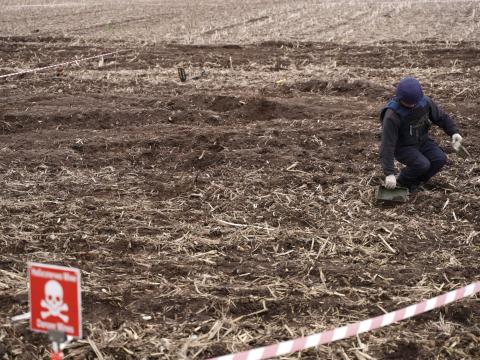Smartphones Help Push Network to Dismounted Soldier
The U.S. Army’s goal to push the network down to the dismounted soldier is now reality as Rangers units and the 10th Mountain Division begin employing Nett Warrior. But developers are not resting on their laurels. They already are adding advancements to increase capability and improve functionality.
“We have begun fielding this as part of Capability Set 13,” says Lt. Col. Adrian Marsh, USA, product manager for ground soldier systems, within Program Executive Office Soldier. Nett Warrior also is part of the directed requirements for fielding in Capability Set 14. The program evolved over time to move away from developmental solutions to off-the-shelf ones, which Col. Marsh says resulted in dramatic cost savings. It additionally allows the Army to leverage quick advancements in industry to increase performance each year. The colonel calls the approach a game changer compared to older programs.
The technology itself is altering operations overall as well. “It’s the first time we’re really providing the network down to the dismounted soldier,” Col. Marsh explains. From a large-scale capacity standpoint, this offering is a capability leap that will alter both paradigm and parity on the battlefield. “Putting the network in the hands of dismounted team leaders ultimately will enable that dismounted leader to bring the full brunt of joint-force capability to bear,” he adds.
The government runs the Nett Warrior program without a prime contractor, making it nimble to respond to customer requests. “We live by soldier feedback,” Col. Marsh says. The program integrates user opinion into all its software drops. The colonel states that users at the Network Integration Evaluation (NIE) and from the field are reporting positive use with the system as well as offering improvement ideas. In NIE 14.1 in October, developers introduced a collaborative planner system that enables a leader to put in a collaborative plan and objective, then draw on the screen to demonstrate concepts visually. Think John Madden tracing on the screen during a football broadcast, Col. Marsh says. That upgrade is a result of requests from soldiers.
Developers also are integrating the Samsung Note 2 smartphone into the system as the end-user device. It serves as a handheld computer connected to the dismounted tactical network. Functions normal in the commercial realm such as cellular and Wi-Fi capabilities are disabled. When choosing which off-the-shelf technology to buy for such incorporation efforts, program personnel evaluate several factors, such as whether or not it can be unlocked and modified at its root and whether it meets minimum processing levels. Quad-core phones are powerful, making it relatively simple to find that capability. Internal memory must be at least 32 gigabytes. The smartphones also must have USB connections and the ability to load apps.
Jason Regnier, Col. Marsh’s deputy, says that by integrating the devices from the private sector, the Army keeps up with Moore’s Law while saving money on development. Soldiers benefit from outside investment in research and development that yields enhanced processing, memory and graphics.
The Defense Department acquisition cycle is yearly, while the smartphone cycle is about eight months, Regnier says. One challenge is to order enough of the platforms before they sell out, leaving only the newer, more expensive models available. The military buys from manufacturers or wholesalers, because generally when a commercial carrier sells the phones, they are locked. While the Army tested the Note 1 for Nett Warrior, Samsung sold them all to Verizon, so developers had to move on to the Note 2, which was better, but required additional testing. “I’m sure it will happen again,” Regnier says. Nett Warrior software does not run on every smartphone because some platforms are unique or proprietary. For the end-user devices, the Nett Warrior team is focusing on commercially available Android-based products. Ruggedization of the commercial wares has not been an issue. Nett Warrior personnel find that the devices pass each environmental or electromagnetic test they throw at them. Manufacturers rarely discuss survivability because it is not of major importance to their key market, but the smartphones stand up to military needs. Using commercial devices has the additional advantage of offering familiarity to troops. Developers originally released an interface with a military design, but soldiers wanted designs similar to those they had on their personal devices so they could use them intuitively.
Some features have to differ for specific purposes. Maps, for example, use real imagery, not graphic representations. Once users are logged into a system, they can see everyone else on the network, enhancing situational awareness and streamlining operations. Col. Marsh explains, “That’s one of the key enablers.”
Future plans for Nett Warrior include adding an overlay function that will connect with the Joint Battle Command-Platform. The change is targeted for the NIE 14.2 timeframe. Because of the NIE’s twice-yearly schedule, Nett Warrior developers are able to stay current with technology as they field and upgrade their product. However, the timing does make it difficult to incorporate soldier feedback from one event by the next one. They typically require a two-NIE cycle to change and adjust software.
Moving forward, more soldiers will enjoy the benefits of the dismounted system. “The next five years should see us getting close to [complete fielding], which right now is 30 brigade combat teams,” Col. Marsh says. Additionally, more applications will be leveraged off the Nett Warrior handheld device, whatever it might be in a particular iteration. “Our program is constantly re-evaluating handhelds,” he explains. “We want to keep our users up to where the market is.”
As they look ahead, Nett Warrior program officials would like to enable some of the capabilities available through the smartphones they use, such as those disabled Wi-Fi and cellular services. One of the goals of the program is to provide more information to soldiers through different means, but because of current security and other reasons, programs cannot take advantage of all available options. Nett Warrior personnel are working with various organizations, including the Defense Advanced Research Projects Agency and the Communications-Electronics Research, Development and Engineering Center, to determine methods for turning those services on and offering additional throughput to dismounted soldiers.
Regnier says a misconception about Nett Warrior is that because it includes smartphones, users do not require radios. “There are not cell phone towers all over Afghanistan,” he states. There is commercial cellular available in the Middle-Eastern nation, but it is not as prevalent as in more developed countries nor is it readily usable for military activities. Also, the phones act like small computers and run with low bandwidth levels. Unlike smartphones or tablets employed by consumers from the general public, soldiers cannot turn on their Nett Warrior handhelds and start downloading. Programs and applications must be preloaded; even maps cannot just be pulled over the air. Regnier explains that the idea that these devices can be used in the field as they are at home is another misconception about his program. When tactical cellular is enabled for this functionality, soldiers might enjoy those capabilities.
Work is underway to offer such services, including 4G high-data, high-bandwidth networks that are secure. When these services are ready, Nett Warrior officials can turn on the phone functions they previously disabled. Adding Defense Department-demanded security reduces throughput. Though rates are higher than in the past, they still lag far behind commercial 4G networks. If cellular capabilities are restored to the devices, the result will be a big enabler for combat.
In looking at the future, developers are not concerned about shifting global priorities. The system functions much the same regardless of environment, including jungle, desert or arctic. Providing all those services out to troops wherever they may be requires a team effort. Nett Warrior works closely with programs throughout the Army to integrate their capabilities with the goal of pushing robust communications down to the dismounted soldier. But industry has a big role to play in the success of this lower-echelon network, and officials hope companies will participate.
Regnier says the message he wants to put out is that Nett Warrior now includes small, handheld computer capabilities and that the goal of the program is to give soldiers information more rapidly. Industry members can assist by creating more lightweight, secure communications resources. Soldiers want bandwidth, and they want information; those offerings make warfighters more survivable, lethal and capable. Private developers can help deliver all these capabilities and in the process play a role in the transformation of the Army as it pushes information down to all levels of leadership. “This is a giant step,” Regnier explains.
Terrorist groups already are conducting business by passing information at tactical levels, often through cell phones. They can move through complex urban environments using commercial networks. But the Army’s capabilities will be more robust, connecting dismounted soldiers to the power of the full force. Col. Marsh says, “It’s going to be a game changer in how we fight, I think.”
Industry does not have to go out of its way to create what the military wants. Regnier explains, “One other thing the Army is doing that I think is a little more abstract is using the commercial interfaces as they are.” In other words, when systems developers ask for apps that have defense applications, they give instructions to use standard, publicly available kits from common commercial entities. The decisions standardize applications not only for Nett Warrior, but also for the larger Army. Regnier says the Marine Corps is interested in the program idea and process as well.





Comments